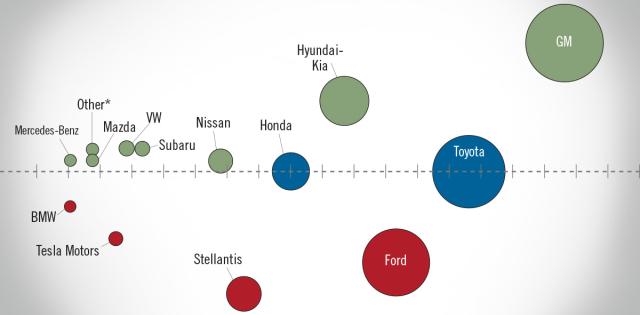The article below is sourced from Bloomberg Wire Service. The views and opinions expressed in this story are those of the Bloomberg Wire Service and do not necessarily reflect the official policy or position of NADA.
Ford Motor Co. is recalibrating its electrification strategy yet again, canceling plans for a fully electric sport utility vehicle in a shift that may cost the carmaker around $1.9 billion.
In addition to scrapping an all-electric three-row SUV that already had been delayed, Ford will further postpone a next-generation electric pickup and reduce spending on EVs to 30% of its annual capital expenditures, from about 40% previously. The automaker also announced Wednesday it’s shaking up battery-sourcing plans, citing the need to better compete with lower-cost Chinese competitors.
The actions amount to further pullback by Chief Executive Officer Jim Farley, who initially accelerated Ford’s shift to EVs when he took over the top job almost four years ago. The automaker incurred significant costs spooling up production as industry sales growth began to taper off, leading Ford to forecast that its EV unit will lose as much as $5.5 billion this year.
Farley is now betting Ford can deliver EVs that are priced on par with traditional vehicles, including a battery-powered midsize pickup truck due to debut in 2027, and turn a profit on these models within a year after they launch.
“This is a tremendous pivot for us, and we’re not going to make a tremendous pivot without doing a lot of homework to convince ourselves this is the exact right plan,” Farley, 62, said in an interview. “I’m very confident.”
Ford shares rose 2% as of 9:34 a.m. in New York. The stock had dropped 12% this year through Tuesday’s close.
EV Criteria
Ford has responded to the EV demand slowdown by cranking up output of gas-electric hybrid models, which have been better received by consumers. Farley is particularly high on a type of hybrid called extended-range electric vehicles, or EREVs, that have taken off in China. The vehicles use a small gasoline engine to keep an on-board battery charged while driving, enabling longer driving range.
Ford now is considering extended-range EV technology for its next-generation three-row SUVs, as it looks at offering a range of powertrain options throughout its lineup. But the automaker ultimately determined it couldn’t make money on an all-electric big SUV.
“We loved our three-row crossover and I was so excited to show everyone the work we did,” Farley said. “But there was just no way it would ever meet our criteria of being profitable.”
As a result of this change of plans, Ford will take a special non-cash charge of about $400 million related to writing down the value of manufacturing assets it will no longer use. The Canadian plant where the electric SUV was going to be built is now slated to produce highly profitable, combustion engine-powered pickups.
Ford may also incur as much as $1.5 billion in additional expenses, including cash expenditures, in future quarters as special items tied to canceling the electric SUV and shifting powertrain options.
While the SUV will fall by the wayside, Ford is going to produce a new fully electric commercial van in Ohio starting in 2026, followed by two new pickups in 2027. One of those trucks will be a medium-size model based off a platform headed up by the former engineering lead of Tesla Inc.’s best-selling Model Y. The other is a next-generation truck Ford will build in Tennessee about two years later than initially planned.
To improve the financial performance of its EV business, Ford will boost its mix of battery production in the US to qualify for manufacturing tax credits included in the Biden administration’s 2022 Inflation Reduction Act. The carmaker is working with one of its cell suppliers — South Korea’s LG Energy Solution — to shift some of the battery output needed for Mustang Mach-E electric SUVs to Holland, Michigan, from Poland next year.
“An important enabler to achieving that profitability is around the mix of the battery production that’s in the US that’s going to qualify for the advanced manufacturing tax credit,” John Lawler, Ford’s chief financial officer, said in an interview. “That’s going to be a big part of our walk to profitability.”
BlueOval SK — Ford’s joint venture with another South Korean cell manufacturer, SK On — also will start making batteries for the automaker’s current E-Transit vans earlier than planned, beginning in mid-2025.
By late next year, BlueOval will produce cells for the commercial van that will be built in Ohio. The automaker has found its commercial customers have been more receptive to EVs.
Low-Cost Batteries
Ford is on track to start making lower-cost lithium iron phosphate, or LFP, batteries in Michigan beginning in 2026. The automaker expects this to be the first LFP cell plant in the US and for the batteries to qualify for IRA tax credits of up to $7,500 for consumers. Ford pared back the planned capacity for the factory by almost half late last year.
Farley said the midsize pickup that will be powered by the LFP battery made in Michigan will be cheaper to own and operate than a traditional internal combustion engine or hybrid model.
“It’s a game-changing product from a cost-of-ownership standpoint,” Farley said.
He wouldn’t say when Ford’s EV unit, called Model e, will turn a profit. Those answers may come in the first half of next year, when the company plans to provide an update on its electrification strategy.
For now, Farley said Ford’s approach to any proposed new EV is simple: “We don’t approve ’em unless they’re going to be profitable in the first year.”
For more stories like this, bookmark www.NADAheadlines.org as a favorite in the browser of your choice and subscribe to our newsletter here:











